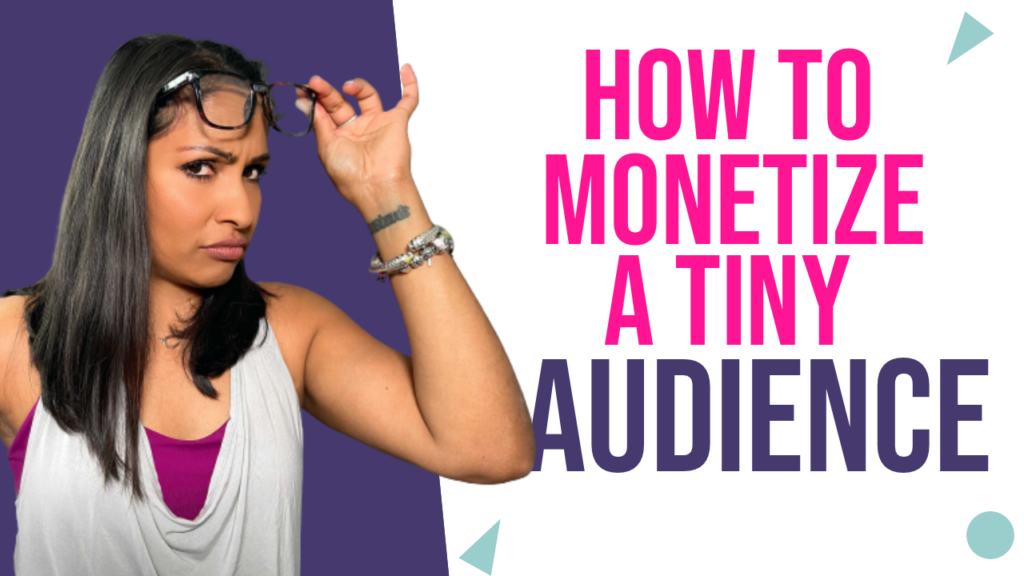Over the years, I have worked with “influencers” who have 100,000+ social followers and massive email lists, and I have worked with people who have tiny audiences or are completely starting from scratch. What’s funny is that both types of clients come to me with the same goal: to grow their audience and make more money. But growing an audience and monetizing an audience are two very different skillsets. And at the end of the day, it’s not the size of your audience that matters — it’s what you do with the audience you have that makes your business. In this article I will show you how to monetize a tiny audience.
Get Crystal Clear On Their Pain … As They Understand It
Your audience is waiting for the right offer. They’re waiting for someone to come to them in their pain and throw them a lifeline. Which is why your first step to monetizing your audience is getting specific to your audience’s pain…as they understand it.
Start by mining your own healing experiences to show you understand their pain. We help our clients flesh out the specifics of their healing journey and identify the point where they decided that enough was enough. Pull out those pivotal, painful moments, and tailor your messaging to what would have really helped you in those moments.
There were times in your past when you would have rejected an offer like yours, and there were times you would have grabbed onto the offer desperately. What is the magic messaging that would have grabbed your attention? When you get clear on your audience’s pain, as they understand it, you essentially narrate their lives as they’re living it. If you can communicate what your client is going through, you’re proving that you really understand them.
- Good messaging says, “Here’s what we do.”
- Great messaging says, “We understand you.”
- Magic messaging says, “Here’s what we do, and we do it this way because we understand you.”
Your prospective client’s biggest fear is that they cannot be fixed. That no one can help them. If you can show them that you see them in all their messiness, and you’re not daunted by the challenge, they’re going to jump on your offer with both hands.
Own Your Authority
Who is the most successful client in your program? Right away, your answer should be, “Me.” You are your own best case study. You are living your program and following what it teaches. That’s what allows you to coach at a level of depth.
Now, you need to share your story in its entirety with your audience. Vulnerability is a crucial part of being a great coach, but it’s not enough on its own. You also have to own the authority piece.
Sara Blakely, CEO of Spanx, is one of my mentors and a phenomenal human being. She has a huge social following because she tells two parallel stories: the story of a ditzy mom and the story of a super successful billionaire.
The first story says, “I’m one of you.” The second says, “I’m also a billionaire CEO.” It’s the combination of both stories told together that makes us want to listen to her.
What I see too often with my coaches is that they tell the vulnerable stories but they don’t own their authority and take back their power. You need to structure your messaging to say, “Yes I was a mess, and here’s what it felt like. But then I went through my process and here’s what happened next.” That way, your audience will not only relate to you, but they’ll trust you enough to listen to what you have to say.
Balance Your Content to monetize a tiny audience
There are three types of content you can produce for your program. There’s content that always has a call to action. The kind of content that says, “Click here!” “Buy now!” “Make the call!” But if you constantly asking your audience to act, they will quickly get tired of your pitch.
The second type of content is my personal preference. This content provides a certain amount of value, a taste of your larger message that concludes with something like, “Want more of this? Take action now.”
The final content type is a pure value piece, whether that’s an informative video or a downloadable PDF, that doesn’t include a path to action. There may be a reminder or an encouragement piece, but the content itself stands alone. The key to successful programming is to balance all three types of content. To provide just enough value without giving away your work for free, and to encourage your audience to act without pressuring or bombarding them.
Have a Sales Process That Works
The final and maybe most important piece to monetizing your audience is to have a sales process already in place. In the past, I made the mistake of doing a 5-day challenge. A challenge where I put out freebies and downloads every day for five days. Hoping to gain trust and prove I had the goods.
As noble as it sounds it didn’t work. Because at the end of the five days, I wasn’t able to monetize effectively. I put out this valuable content. But I didn’t have a sales process to harvest the goodwill, the trust, and the connection I had created. Today, I structure content by giving enough value so my audience can open their minds and increase their understanding of what is possible. Then, once they’re intrigued, I give them a clear path to take action to get where they want to be.
That’s how you sequence your content and keep your audience coming back until they get to a place where they’re ready to commit. That’s how you tune in to your audience, no matter its size, and convert them into sales.
Did you love our article about how to monetize a tiny audience? Continue reading in our blog.



